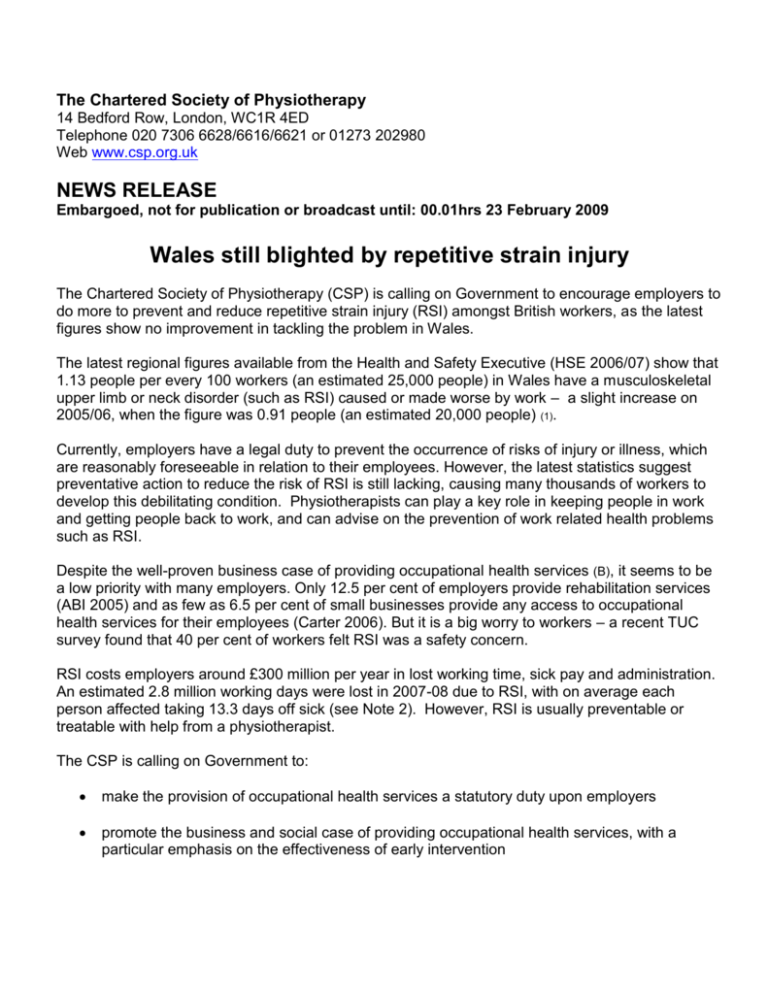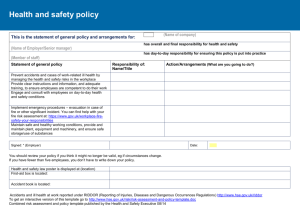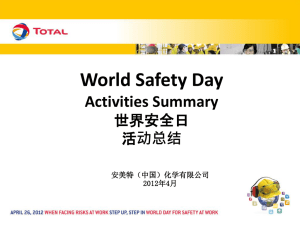rsi wales1 - The Chartered Society of Physiotherapy
advertisement

The Chartered Society of Physiotherapy 14 Bedford Row, London, WC1R 4ED Telephone 020 7306 6628/6616/6621 or 01273 202980 Web www.csp.org.uk NEWS RELEASE Embargoed, not for publication or broadcast until: 00.01hrs 23 February 2009 Wales still blighted by repetitive strain injury The Chartered Society of Physiotherapy (CSP) is calling on Government to encourage employers to do more to prevent and reduce repetitive strain injury (RSI) amongst British workers, as the latest figures show no improvement in tackling the problem in Wales. The latest regional figures available from the Health and Safety Executive (HSE 2006/07) show that 1.13 people per every 100 workers (an estimated 25,000 people) in Wales have a musculoskeletal upper limb or neck disorder (such as RSI) caused or made worse by work – a slight increase on 2005/06, when the figure was 0.91 people (an estimated 20,000 people) (1). Currently, employers have a legal duty to prevent the occurrence of risks of injury or illness, which are reasonably foreseeable in relation to their employees. However, the latest statistics suggest preventative action to reduce the risk of RSI is still lacking, causing many thousands of workers to develop this debilitating condition. Physiotherapists can play a key role in keeping people in work and getting people back to work, and can advise on the prevention of work related health problems such as RSI. Despite the well-proven business case of providing occupational health services (B), it seems to be a low priority with many employers. Only 12.5 per cent of employers provide rehabilitation services (ABI 2005) and as few as 6.5 per cent of small businesses provide any access to occupational health services for their employees (Carter 2006). But it is a big worry to workers – a recent TUC survey found that 40 per cent of workers felt RSI was a safety concern. RSI costs employers around £300 million per year in lost working time, sick pay and administration. An estimated 2.8 million working days were lost in 2007-08 due to RSI, with on average each person affected taking 13.3 days off sick (see Note 2). However, RSI is usually preventable or treatable with help from a physiotherapist. The CSP is calling on Government to: make the provision of occupational health services a statutory duty upon employers promote the business and social case of providing occupational health services, with a particular emphasis on the effectiveness of early intervention provide incentives to employers, such as tax relief, on the provision of occupational health services Pauline Cole, CSP spokesperson and member of ACPOHE (Association of Chartered Physiotherapists in Occupational Health and Ergonomics) said: ‘There is a clear opportunity for employers to do more to provide occupational health services both with regard to prevention of RSI and rehabilitation. The CSP is calling on the Government to both encourage and enforce measures to address this with legislation, combined with incentives and best practice guidance. We may then, after the frustration of many years of no progress, begin to see some reduction in the rates of this almost completely preventable condition. ‘The Government’s welfare reform proposals include important measures to support staff returning to work after health problems, such as RSI, through rehabilitation services such as physiotherapy. The CSP fully supports these initiatives but argues more needs to be done to prevent RSI from occurring in the first place and, if it does occur, to provide early intervention treatments to prevent the problem getting so bad people have to stop work altogether.’ The most recent overall figures from the Health and Safety Executive (HSE) are for 2007/08. These show that 213,000(2) people in work had a musculoskeletal upper limb or neck disorder that was caused or made worse by work. There has been little progress in tackling the problem in six years - of the figures for 2007/8 over a third, 81,000 were new cases, compared with a similar figure of 87,000 people in 2001/02 (3), when 222,000 people in work were found to be suffering (2). Health and Safety Executive figures analysed by the Labour Research Department for the CSP show that the jobs where workers are most likely to develop a musculoskeletal disorder caused or made worse by work, mainly affecting the upper limbs or neck (4) are: Process, plant and machine operatives (1.21 per 100 workers), Skilled construction and building trades (1.14 per 100 workers) Health and social welfare associate professionals (1.10 per 100 workers) Ends For further media information please contact the CSP press office on 020 7306 6616 (out of hours mobile: 07786 332 197) or Ann Stirling on 01273 202980 (mobile: 07939 153513). Tables Appendix (1) By region Table A 2006/07: Estimated prevalence and rates of self-reported musculoskeletal disorders mainly affecting the upper limbs or neck, caused or made worse by work, by country and government office region within England, for people ever employed. Government office Rate per 100 ever Prevalence region employed South West 1.31 51,000 West Midlands 1.24 48,000 North East East Midlands Wales Yorkshire and Humber North West Scotland East London South East 1.20 1.17 1.13 1.13 0.94 0.93 0.82 0.80 0.69 22,000 38,000 25,000 41,000 47,000 36,000 35,000 41,000 43,000 England Great Britain 0.99 0.99 365,000 426,000 HSE, Table ULNGOR1E - 2006/07 http://www.hse.gov.uk/statistics/lfs/0607/ulngor1e.htm Table B 2005/06: Estimated prevalence and rates of self-reported musculoskeletal disorders mainly affecting the upper limbs or neck, caused or made worse by work, by country and government office region within England, for people ever employed. Government office Rate per 100 ever Prevalence region employed North East 1.24 23,000 East Midlands 1.08 35,000 Yorkshire and Humber 1.05 39,000 West Midlands 0.95 37,000 Wales 0.91 20,000 South East 0.91 57,000 East 0.83 35,000 North West 0.74 37,000 Scotland 0.74 29,000 South West 0.70 27,000 London 0.69 35,000 England Great Britain 0.88 0.87 325,000 374,000 Source: HSE ULNGOR1E - 2005/06 http://www.hse.gov.uk/statistics/lfs/0506/ulngor1e.htm Overall rates Estimated prevalence and rates of musculoskeletal disorders caused or made worse by work, mainly affecting the upper limbs or neck, for people working in the last 12 months (2) Yea Estimated r prevalence 2001/02 222,000 2003/04 259,000 Rate per 100 employed in last 12 months 0.78 0.90 2004/05 2005/06 2006/07 2007/08 217,000 213,000 263,000 213,000 0.75 0.73 0.90 0.70 Source: Table SWIT3W12 - 2007/08 and previous years http://www.hse.gov.uk/statistics/lfs/0708/swit3w12.htm New cases Estimated incidence and rates of musculoskeletal disorders caused or made worse by work, mainly affecting the upper limbs or neck, for people working in the last 12 months (3) Year 2001/02 2003/04 2004/05 2005/06 2006/07 2007/08 Estimated incidence 87,000 90,000 85,000 78,000 107,000 81,000 Rate per 100 employed in last 12 months 0.30 0.31 0.29 0.27 0.37 0.27 Source: Table SWIT6W12 - 2007/08 and previous years http://www.hse.gov.uk/statistics/lfs/0708/swit6w12.htm By occupation Estimated prevalence and rates of self-reported musculoskeletal disorders mainly affecting the upper limbs or neck caused or made worse by current or most recent job, by occupation, for people working in the last 12 months, averaged 2004/05-2006/07. Occupation description Rate per 100 Prevalence employed in the last 12 months Process, plant and machine operatives 1.21 13,000 Skilled construction and building trades 1.14 13,000 Health and social welfare associate professionals 1.10 12,000 Textiles, printing and other skilled trades 0.92 5,000 Culture, media and sports occupations 0.88 12,000 Leisure and other personal service occupations 0.80 4,000 Secretarial and related occupations 0.79 7,000 Transport and mobile machine drivers and 0.78 13,000 operatives Skilled metal and electrical trades 0.77 9,000 Science and technology associate professionals 0.73 4,000 (4) All occupations Source: HSE, Table ULNOCC2_3YR - Averaged 2004/05 - 2006/07 http://www.hse.gov.uk/statistics/lfs/0607/ulnocc2_3yr.htm 0.79 231,000 (B) The business case Physiotherapists and other allied health professionals employed by companies are in a prime position to help employees to keep healthy by enabling the individual to understand how to prevent conditions becoming long term, to reduce reoccurrence, and strategies to self manage effectively. Physiotherapy has a significant role to play in promoting good health and wellbeing especially in the areas of exercise prescription, activity management and smoking cessation, impacting across all age groups. For example, AstraZeneca recognises that personal wellbeing is essential for employees to effectively build the company’s innovation and creativity. (HSE 2007b) In 2000 it started its ‘Wellbeing in AstraZeneca’ programme for its 10,000 staff in the UK. Through the provision of rehabilitation and treatment services such as physiotherapy, and promoting healthy lifestyles with access to sports facilities and health screening, the company has saved £200,000 a year in health insurance spend and absence levels are 31% lower than average levels. Notes to editors: 1. Further information on RSI and how to find a physiotherapist to help prevent and/or treat RSI is available from the Chartered Society of Physiotherapy (CSP). The CSP is the professional, educational and trade union body for the UK's 49,000 chartered physiotherapists, physiotherapy students and assistants. Please visit our web site at www.csp.org.uk or call 0207 306 6666. 2. RSI is a general term, rather than a medical diagnosis, that covers a range of conditions known as work-related upper limb disorders (WRULD) that can result in pain, sometimes very severe, in the limbs, fingers, wrists, forearms, neck and shoulders. Any activity that involves prolonged maintenance of awkward or static postures, high rates of repetition or exertion of force can mean there is a risk of developing WRULD or RSI. Information on the number of lost working days can be found in HSE Table SWIT1 - 2007/08. In 1995/96 HSE estimated the cost of upper limb disorders at between £208 and £221 million per year. Allowing for inflation, these figures would now be between £285 million and £304 million. 3. Breakdowns by occupation and region are not yet available for 2007/8. The most recent HSE figures available are for 2006/07. Full details on the HSE web site www.hse.gov.uk. 4. The Hazards Campaign (http://www.hazards.org/strains) and charity RSI Action (http://rsiaction.org.uk) have information and resources available on RSI. International RSI Awareness Day takes place on the last day of February each year. 5. Research references alphabetically ordered: i) Association of British Insurers (ABI). 2005 Improving health at work: (UK) Employers attitudes to Occupational Health. London: Association of British Insurers. ii) Carter S, Mason C, Tag S. (2006) Lifting the barriers to growth in UK small businesses. The FSB biennial membership survey, 2006. Stirling: University of Stirling. iii) Health and Safety Executive. (HSE) (2007b) The business benefits of health and safety – case studies. Sudbury: Health and Safety Executive. Available at: http://www.hse.gov.uk/businessbenefits/ (accessed 28 November 2007) iv) TUC biennial survey of safety representatives October 2008




